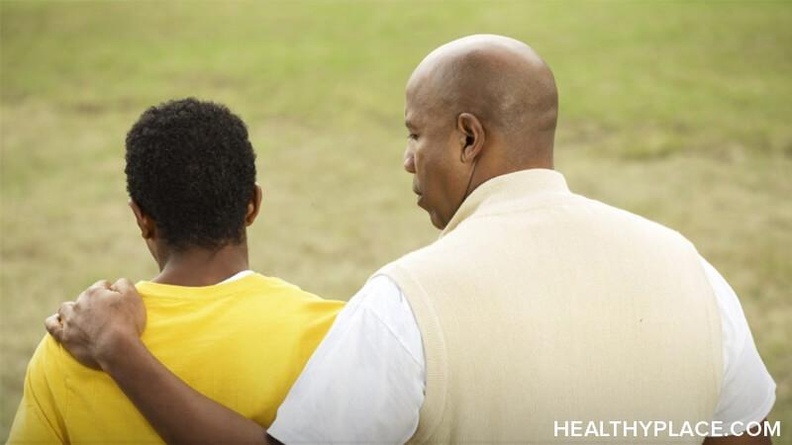High-Suicide Families Eyed By Genetic Scientists

Suicide can run in families, but psychiatrists aren't sure whether high-suicide families are plagued by genetic inheritance or learned behavior.
Allen Boyd Jr. watched suicide burn its way through his family.
First was his mother, with a .38 caliber handgun in a hotel room; then his brother, with a shotgun in the basement; then his second brother, poisoned in a boarding house; then his pretty sister, dead in her master bedroom. Then, three years ago, his father turned a gun on himself, leaving Allen Boyd Jr. alone with a dark history.
Worried About the Suicide Gene
Boyd has never loaded a gun, never stuck one in his mouth. At 45, the North Carolina man thinks about meeting a "really jolly woman" and starting a family. But he knows, too, that he is a Boyd: For a while after his father's death, the thoughts crept into his head every five minutes, repeating themselves, disrupting his sleep.
"It's in me," he said.
Psychiatrists agree now on a point that was long debated: Suicide can run in families. They do not know, however, how this risk is transferred from one family member to another -- whether it is "learned" behavior, passed on through a grim emotional ripple effect, or a genetic inheritance, as some scientists theorize. But new research published this week in the American Journal of Psychiatry prepares ground for a genetic search, suggesting that the trait that links high-suicide families is not simply mental illness, but mental illness combined with a more specific tendency to "impulsive aggressiveness."
"It gets us beyond the witchcraft argument, that you're a walking time bomb," said Dr. J. Raymond DePaulo, a Johns Hopkins psychiatrist and prominent suicide researcher.
At stake in this discussion is the hope that doctors could intervene more effectively if they could identify risk factors. Dr. David Brent, the study's lead author, was launched on a career researching suicide while he was working on an adolescent psychiatric ward where a very common professional judgment call was determining which children were suicidal. One day, after he had sent one girl to a psychiatric ward and another home, the father of one girl confronted him angrily, asking what he had seen in one girl and not the other. Brent, now a professor of psychiatry at the University of Pittsburgh School of Medicine, realized he had no good answer.
"I found myself, and the field, bereft of knowledge," he said. "It was like the toss of a coin."
Suicide on the Brain
In recent years, researchers have edged closer to a physiological marker of suicide. When analyzed after death, the brains of people who committed suicide show a low level of a metabolite of seratonin, a neurotransmitter that is involved in the control of impulses. But although a seratonin deficiency may mark a heightened risk of suicide -- as much as 10 times what is normal -- that discovery is useless to clinicians, since it would require patients to undergo a spinal tap.
As they search for genetic commonality, researchers are drawn to those rare, unlucky families who have suffered from rashes of suicide.
When Margaux Hemingway's overdose death was ruled a suicide in 1996, she was the fifth member of her family to kill herself in four generations -- after her grandfather, the novelist Ernest Hemingway; his father, Clarence; Ernest's sister, Ursula, and his brother, Leicester.
Other clusters have been sought by researchers. Among the Old Order Amish, researchers from the University of Miami found that half the suicides of the last century -- they numbered only 26 -- could be traced to two extended families, and 73 percent of them could be traced to four families that made up only 16 percent of the population. The clustering could not be explained by mental illness alone, since other families carried risks for mental illness but no risk for suicide.
The successive studies have shed little light on what differentiates them from their more resilient neighbors -- and whether the differences are sociological, psychological, or genetic, said one suicidologist. Most specialists say that many factors interact to cause suicide.
"It's impossible to differentiate [between causes]. When you have a family history that is quite profound, how do you rule out the fact that you have one deceased parent and a second parent bereaved?" said Dr. Alan Berman, president of the American Society for Suicide Prevention. "We'll be arguing this for the next hundred years."
For Boyd, as for many survivors, the genetic explanation is less important than the long, bitter reverberation of his mother's death.
When his mother shot herself in a hotel room, Boyd said, the family splintered in their reactions: Although his father bitterly criticized her act, his brother Michael immediately said he wanted to be with her, and shot himself, at 16, a month later. Michael's twin, Mitchell, followed suit in a long series of attempts, including an attempt to throw himself off of the tallest building in Asheville, N.C., and was ultimately diagnosed with paranoid schizophrenia. He died in a boarding house at age 36, after drinking toxic chemicals.
Boyd's sister, Ruth Ann, got married and gave birth to a boy, Ian, who was 2 years old when -- for reasons that are still unclear -- she shot the baby and then herself. She was 37. Four months later, Allen Boyd Sr. was dead, also by his own hand.
Boyd said he has made three suicide attempts himself.
"She planted a seed in each and every one of us. My mother's act gave us all the option," said Boyd, who was featured in a series in the Asheville Citizen-Times and is writing a memoir, "Family Tradition: The Suicide of One American Family."
"Human beings are a pack animal, and we depend on each other," said Boyd, a towering man with a twangy, story-telling voice. "If I can just get that message across to people, maybe we can put a dent on this suicide thing. If you can just drag your butt through your sorry lives, don't put your family through this."
Suicide More Than Just A Genetic Trait
Scientists, though, say the trait passed between family members goes beyond the suffering of a household into the deep coding of genes. As he embarked on his most recent study, Brent was already searching for a secondary trait -- something beyond mental illness -- that connects suicidal families. His results, he said, encourage him on the genetic route. Brent's team looked at individuals, their siblings, and their offspring, and found that the offspring of the 19 suicidal parents who also had suicidal siblings were at sharply higher suicide risk themselves. They attempted suicide, on average, eight years before their counterparts with less of a family history.
Although they looked at secondary traits such as abuse, adversity, and psychopathology, researchers found that the most predictive trait by far was "impulsive aggression." The obvious next step, Brent said, would be to identify genes that dictate impulsive aggression.
"We're looking for the trait that's really behind the trait," said Brent. "You're more likely to be able to map genes to those behaviors."
In the fractious field of suicidology, not everyone agrees that genes will supply useful answers. Edwin Shneidman, the 85-year-old founder of the American Association of Suicidology, said the field has perennially been riven by "conceptual turf wars" -- but that at the moment, biochemical explanations may hold sway over sociological, cultural, or psychodynamic theories.
"If you take the phrase 'suicide runs in families,' no one is going to say that points to or implicates a genetic etiology. French runs in families. Common sense tells us that French is not inherited," Shneidman said. "Each family has its history, its mystique. Some families say 'We've been drunks for generations.' Some families say this with some pride."
For his part, Allen Boyd Jr. has improved with psychotherapy and medical treatment for depression. These days, he feels confident enough to contemplate the interesting possibility of one more generation of Boyds.
"My family raised and showed dogs and cats. I do know a little bit about breeding," said Boyd. "If I breed with a woman that's cheerful and positive and always looking to smell the roses, it's possible I could kick this thing."
Source: The Boston Globe
APA Reference
Tracy, N.
(2022, January 10). High-Suicide Families Eyed By Genetic Scientists, HealthyPlace. Retrieved
on 2025, December 7 from https://www.healthyplace.com/depression/articles/high-suicide-families-eyed-by-genetic-scientists



